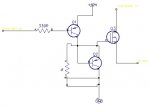ok i have a BIG mosfet (irf1405n) connected to physical pin 12 of the picaxe (28x1 with 16mhz external resonator) via a darlington driver used to swich the 20v for the mosfet to turn on, and i can easily turn the motor on and off using the high portc 1 and low portc 1 commmands, but i cannot get pwm to respond in any way shape or form, eavy at 100% duty cycle there is no response from the pic, a multimeter between the pin and ground shows only 5 volts no matter what the duty cycle ( the pin is high by default because of the low sided switching of the mosfet, motors are off when pin is high)
SOS
SOS
Last edited:


